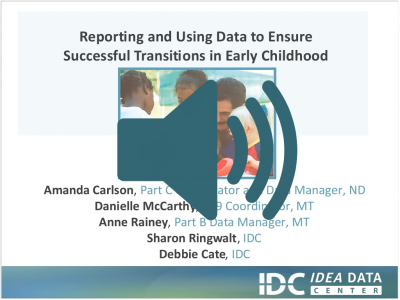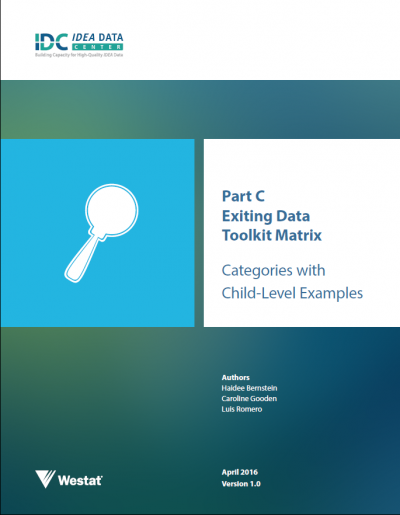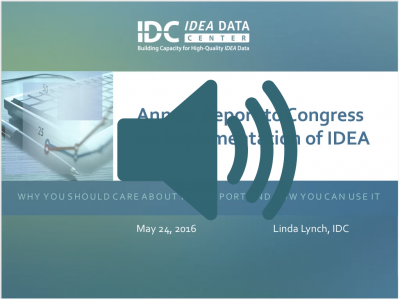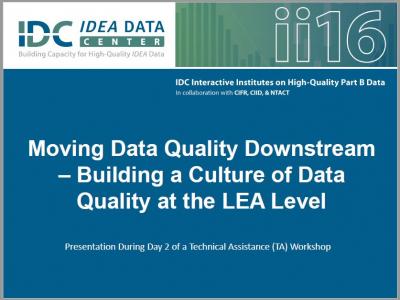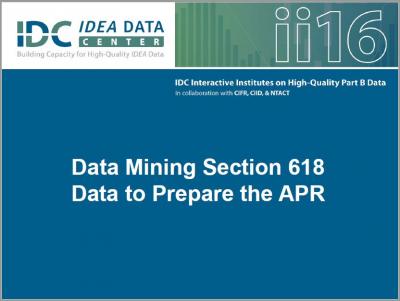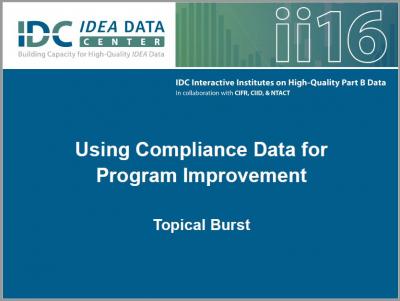Site Search
Results 15 - 21 of 67
Format: Recordings
Reporting and Using Data to Ensure Successful Transitions in Early Childhood WebinarThis webinar highlighted the IDEA state reporting requirements for early childhood transitions for both Part C and Part B, found in the SPP/APR Part C Indicator 8 and Part B Indicators 11 and 12. Participants shared resources related to transition, data collection, and reporting, as well as the use of both Part C and Part B data to facilitate high quality transitions. North Dakota's Part C coordinator and data manager and Montana's 619 coordinator and data manager described how their states collect and use transition data to ensure smooth transitions for all young children as they turn three and move from early intervention services to preschool 619 services.
Format: Checklists, Crosswalks, and Rubrics
Part C Exiting Data Matrix: Categories with Child-Level ExamplesThis matrix is both a standalone product and the fourth section of the IDEA Data Center Part C Exiting Data Toolkit. It contains scenarios for each of the 10 exiting categories. The Part C Exiting Data Toolkit is designed to assist states in reporting high-quality Part C exiting data, required under Section 618 of IDEA. The remaining three sections in the Part C Exiting Data Toolkit are: Part C Exiting Reasons and Categories (Section 1); General Challenges and Potential Solutions (Section 2, Part 1); Specific Challenges, Potential Solutions, and Variation (Section 2, Part 2); and Data Check Patterns and Additional Data Check Patterns to Ensure Non-Duplicated Counts of All Eligible Exiting Children (Section 3).
Format: Recordings
Annual Report to Congress on Implementation of IDEA WebinarThe webinar featured the purpose and history of the Annual Report to Congress on the Implementation of the Individuals with Disabilities Education Act, its current organization and content, links to the report and its data sources, and suggestions for how participants can use the report. The webinar was designed so that participants would have a greater understanding of why it is important to work to improve the quality of IDEA-related data by seeing how the U.S. Department of Education uses IDEA data to meet an annual statutory requirement to report to Congress;. In addition, it was designed to help participants become familiar with a key resource on state and national IDEA data and related information and prompt them to think about how they might use the resource.
Format: Presentations
Moving Data Quality Downstream - Building a Culture of Data Quality at the LEA LevelPresenters and participants discussed strategies that SEAs can use to help LEAs in collecting section 618 and other state-required data that is of high-quality. They explored IDC’s Knowledge Lab that lists various resources around different data collections. The Knowledge Lab contains many resources designed to help SEAs and LEAs gather, collect, validate, and report high-quality data. The discussion allowed for state input on how the state uses or can use these resources.
Format: Presentations
Data Mining Section 618 Data to Prepare the APRThe required measurements for APR Indicators B3, B4, B5, B6, B9, and B10 (the assessment, discipline, LRE, and disproportionality indicators) are based on Section 618 data. This session focused on selected section 618 data submissions and how the data can be explored to provide more in-depth information for use in discussion with state’s APR stakeholders. Presenters demonstrated some practical methods for taking a deeper look at data in the IDEA EDFacts file submissions using readily available data analysis tools (Microsoft Excel).
Format: Presentations
Visualizing IDEA DataIDC staff provided an introduction to data visualization approaches that are particularly useful for presenting IDEA data for the public. Participants learned simple strategies, chart types, and report styles that can be used to visualize the state’s data using Microsoft Excel, PowerPoint, and free online tools. Presenters also provided a set of activities so participants can continue developing their capacity in follow-up to the interactive institute.
Format: Presentations
Using Compliance Data for Program ImprovementIt can be challenging to bridge the huge shift from a focus on solely compliance-driven data to an emphasis on results-driven monitoring. Compliance data can be hard and fast; results-driven data can be harder to pin down. This topical burst provided an overview of compliance data, the interrelationship between compliance and results data, and existing processes that can help bridge the gap between accountability and program improvement.


